
The Chiesa di Santa Margherita de' Cerchi is a 13th-century, Roman Catholic church dedicated to Margaret the Virgin in the centre of Florence, region of Tuscany, Italy. It is among the oldest churches in Florence.

The Chiesa di Santa Margherita de' Cerchi is a 13th-century, Roman Catholic church dedicated to Margaret the Virgin in the centre of Florence, region of Tuscany, Italy. It is among the oldest churches in Florence.
It is first recorded in 1032 and is said, contentiously, to have been the location of Dante's marriage to Gemma Donati in 1285 or 1290. It was certainly the Donati family's parish church and also contains several tombs of the Portinari family, to which Dante's great love Beatrice Portinari belonged, including Monna Tessa, her nursemaid.
The church was consecrated on the day of Saint Margaret. The main patron families of the church in the 13th and 14th century, who had chapels in the church, were the Cerchi, the Donati, and the Adimari families.
The church contains a fine altarpiece of the Madonna and Four Saints by Neri di Bicci. In the entrance is a chapel erected by Jacopo Salviati and his wife, Lucrezia de' Medici. [1]
Tradition holds that visitors can plead in writing to Beatrice to ask her to fix their love lives, leaving the letters in a basket next to her shrine.

Dante Alighieri, probably baptized Durante di Alighiero degli Alighieri and often referred to as Dante, was an Italian poet, writer and philosopher. His Divine Comedy, originally called Comedìa and later christened Divina by Giovanni Boccaccio, is widely considered one of the most important poems of the Middle Ages and the greatest literary work in the Italian language.

Domenico di Tommaso Curradi di Doffo Bigordi, professionally known as Domenico Ghirlandaio, also spelled as Ghirlandajo, was an Italian Renaissance painter born in Florence. Ghirlandaio was part of the so-called "third generation" of the Florentine Renaissance, along with Verrocchio, the Pollaiolo brothers and Sandro Botticelli. Ghirlandaio led a large and efficient workshop that included his brothers Davide Ghirlandaio and Benedetto Ghirlandaio, his brother-in-law Bastiano Mainardi from San Gimignano, and later his son Ridolfo Ghirlandaio. Many apprentices passed through Ghirlandaio's workshop, including the famous Michelangelo. His particular talent lay in his ability to posit depictions of contemporary life and portraits of contemporary people within the context of religious narratives, bringing him great popularity and many large commissions.

Santa Maria Novella is a church in Florence, Italy, situated opposite, and lending its name to, the city's main railway station. Chronologically, it is the first great basilica in Florence, and is the city's principal Dominican church.

Beatrice "Bice" di Folco Portinari was an Italian woman who has been commonly identified as the principal inspiration for Dante Alighieri's Vita Nuova, and is also identified with the Beatrice who acts as his guide in the last book of his narrative poem the Divine Comedy, Paradiso, and during the conclusion of the preceding Purgatorio. In the Comedy, Beatrice symbolises divine grace and theology.
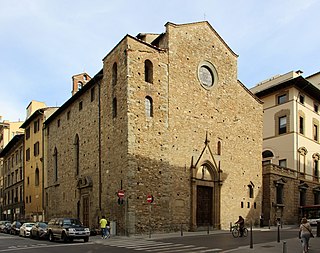
Santa Maria Maggiore di Firenze is a Romanesque and Gothic-style, Roman Catholic church in Florence, region of Tuscany, Italy. This is among the oldest extant churches in Florence.

The Florentine banking family of the Cerchi, minor nobles of the Valdarno, with a seat especially at Acone near Pontassieve, settled in Florence in the early thirteenth century and increased their fortunes. The family became the heads of a consortium of the prominent Guelfs that securely controlled Florence after the battle of Benevento in 1266. In Florence, the Cerchi purchased some of the ancient structures in the closely packed inner city formerly belonging to the counts Guidi, cheek-by-jowl with the proud Florentine family of the Donati, with whom their growing mutual antagonism was expressed in violent episodes that polarized Florence within a couple of decades in a virtual civil war that aligned behind two captains, Corso Donati of the Neri Guelf faction— the "Black" Guelfs of the old noble oligarchy— and Vieri de' Cerchi of the Bianchi, the moderate party that represented itself as champions of working people. The resulting violence lasted, with irruptions of tranquility, into the fourteenth century.

Santa Trinita is a Roman Catholic church located in front of the piazza of the same name, traversed by Via de' Tornabuoni, in central Florence, region of Tuscany, Italy. It is the mother church of the Vallumbrosan Order of monks, founded in 1092 by a Florentine nobleman. South on Via de' Tornabuoni is the Ponte Santa Trinita over the river Arno; across the street is the Palazzo Spini Feroni.

The Sassetti Chapel is a chapel in the basilica of Santa Trinita in Florence, Italy. It is especially notable for its frescoes of the Stories of St. Francis, considered Domenico Ghirlandaio's masterwork.

Santa Maria Maddalena dei Pazzi is a Renaissance-style Roman Catholic church and a former convent located in Borgo Pinti in central Florence.
Santa Margherita may refer to:
Piccarda Donati was a medieval noblewoman and a religious woman from Florence, Italy. She appears as a character in Dante Alighieri's Divine Comedy.
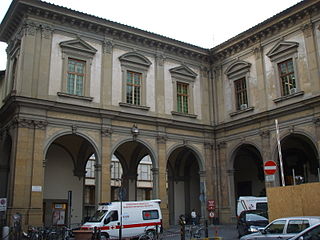
The Hospital of Santa Maria Nuova is the oldest hospital still active in Florence, Italy.

Dante and Beatrice is a painting dated 1883 by the artist Henry Holiday that is on display in the Walker Art Gallery, in Liverpool, England. It is considered to be Holiday's most important painting. It is executed in oil on canvas, measuring 142.2 centimetres (56 in) by 203.2 centimetres (80 in) and was purchased by the gallery in 1884.

Folco Portinari was an Italian banker and several times the prior of Florence. He was the father of Beatrice Portinari, the woman largely identified as the character loved by Dante Alighieri and mentioned in his works.

Raffaello Sorbi was a 19th-20th century Florentine painter, specializing in narrative painting.
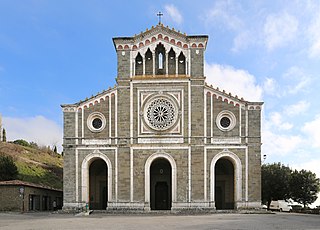
Basilica of Santa Margherita is a Neo-gothic style, Roman Catholic church, located just outside the Tuscan town of Cortona, Italy, at the intersection of Via delle Santucce and Via Sant Margherita, on a hill just below the Fortezza Medicea, and dedicated to a native saint of town, Margaret of Cortona.

The church of Saint Margaret is a 16th-century chapel dedicated to Saint Margaret of Antioch. It is located in Cassina Baraggia, Brugherio, Italy. The church is adjacent to the Villa Brivio, to which it belonged.

Santa Maria or Santa Maria a Campi is a Roman Catholic parish church located on Via Spartaco Lavagnini #26 in Campi Bisenzio, just west of Florence, in the region of Tuscany, Italy.
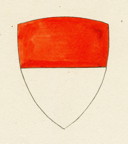
Gemma Di Manetto Donati, commonly shortened to Gemma Donati, was the wife of Italian poet Dante Alighieri.
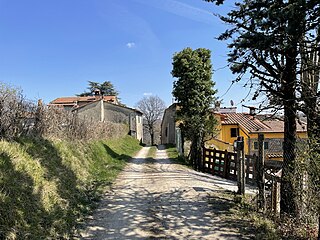
Mangona is a village in the municipality of Barberino di Mugello, in the metropolitan city of Florence, Italy. In the past it was the seat of the homonymous county, which took its name from the Castle of Mangona, now in ruins.
Coordinates: 43°46′16.51″N11°15′26.31″E / 43.7712528°N 11.2573083°E